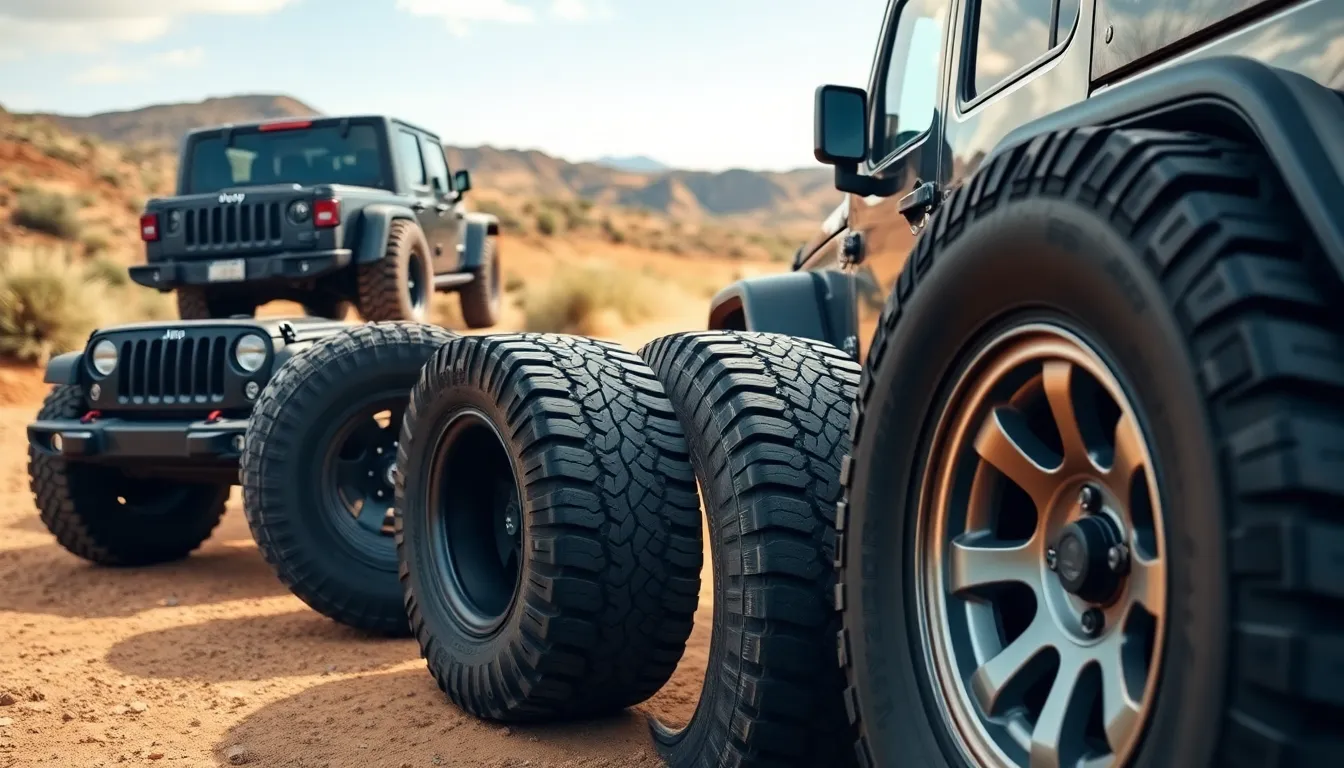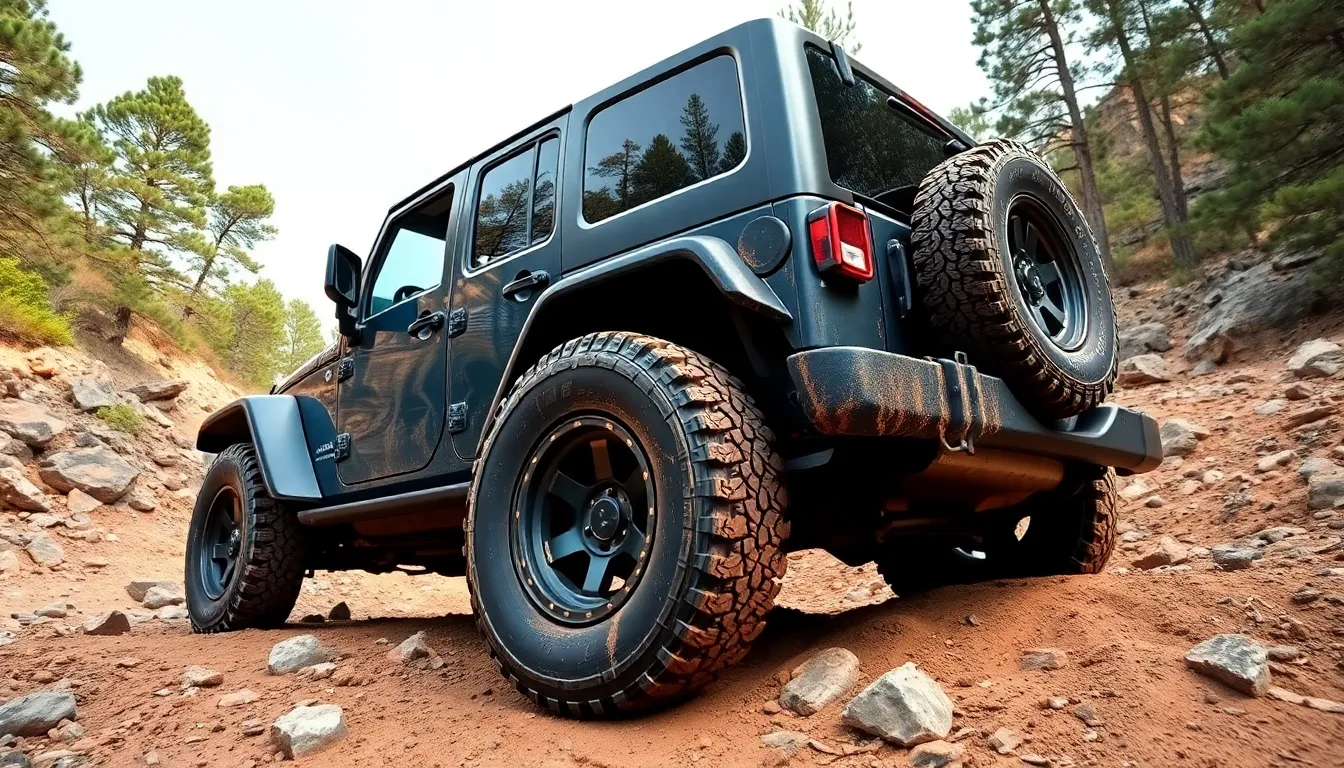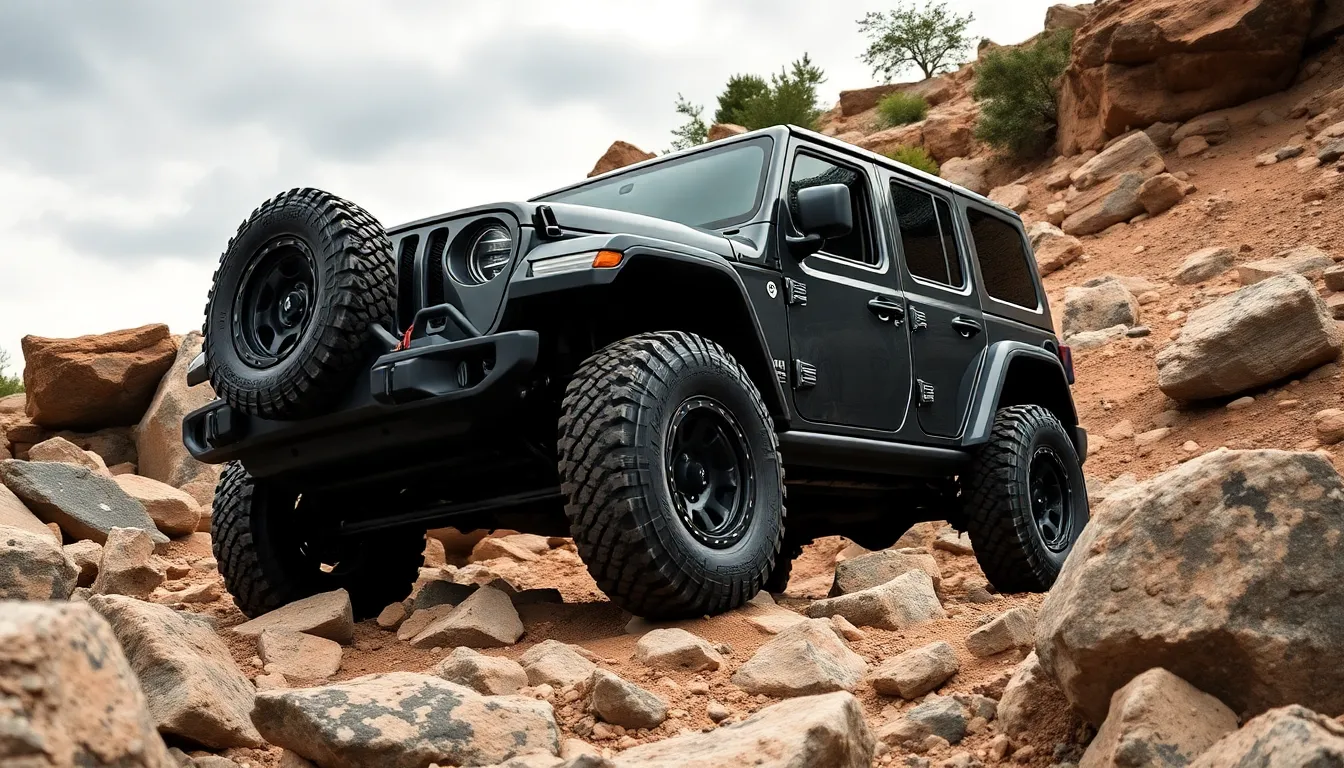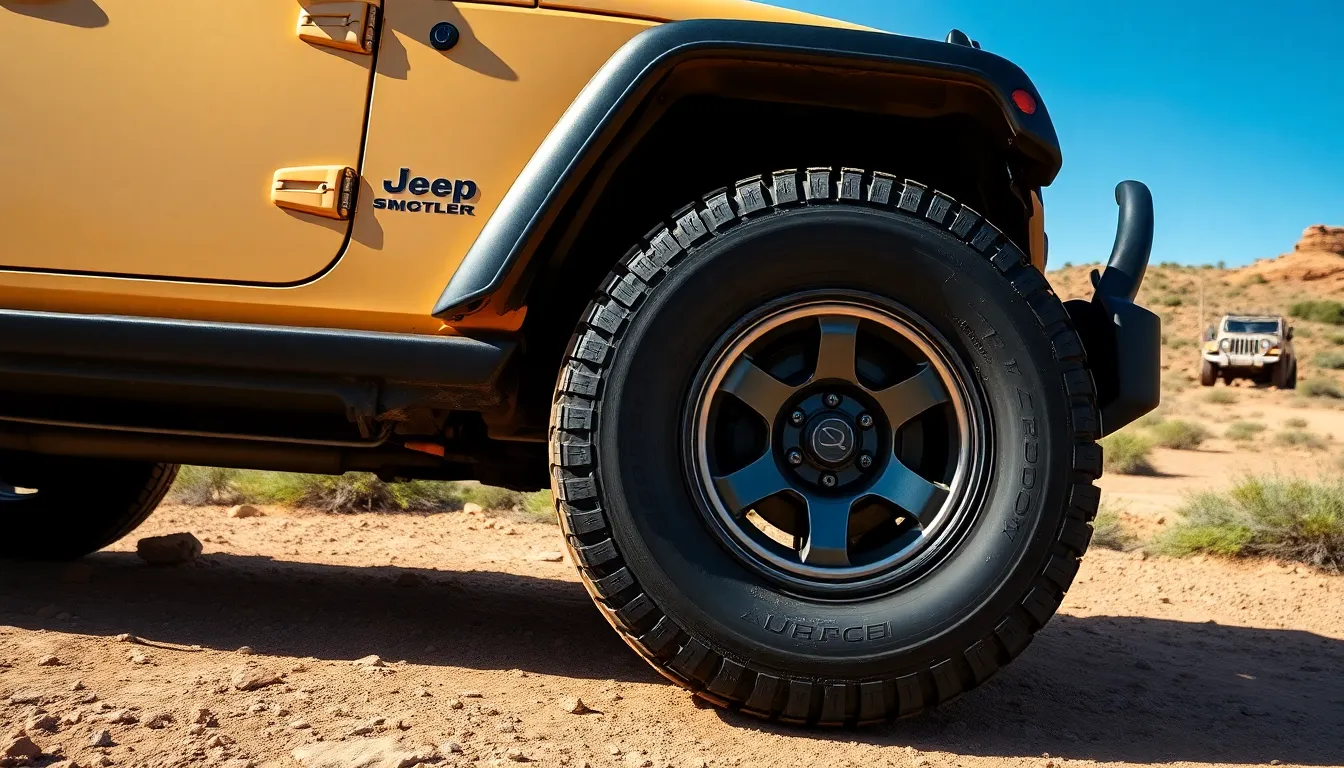When we’re shopping for a Jeep Wrangler or planning our next off-road adventure, understanding stock tire sizes becomes crucial for making informed decisions. Whether you’re a first-time Wrangler owner or considering an upgrade, knowing the factory specifications helps you maintain optimal performance and avoid costly mistakes.
We’ve all been there – standing in the tire shop wondering if that aggressive-looking tire will actually fit our rig without modifications. The truth is, Jeep Wrangler stock tire sizes vary significantly across different model years and trim levels, from the base Sport to the trail-ready Rubicon.
Getting the right tire size isn’t just about looks – it directly impacts your Wrangler’s handling, fuel economy, speedometer accuracy, and warranty coverage. We’ll break down everything you need to know about stock tire specifications, so you can make confident choices that keep your Jeep running smoothly on and off the beaten path.
Understanding Jeep Wrangler Stock Tire Specifications
Jeep Wrangler stock tire specifications contain crucial information that determines your vehicle’s performance characteristics and safety limits. Reading these specifications correctly ensures you maintain proper fitment when replacing tires or planning modifications.
Tire Size Breakdown and Meaning
The tire size format follows a standardized system that reveals exact measurements about your Jeep’s tires. Most Jeep Wrangler models display tire sizes like 245/75R17 or 285/70R17 on the sidewall.
The first number represents tire width in millimeters measured from sidewall to sidewall. A 245mm tire measures approximately 9.6 inches wide while a 285mm tire spans 11.2 inches across the tread surface.
The second number indicates the aspect ratio as a percentage of the tire’s width. A 75 aspect ratio means the sidewall height equals 75% of the tire’s width. Lower aspect ratios create shorter sidewalls that improve handling response but reduce ride comfort over rough terrain.
The letter “R” designates radial construction which is standard for modern passenger and light truck tires. The final number specifies wheel diameter in inches that the tire fits.
| Tire Size Component | Example Value | Measurement Type |
|---|---|---|
| Width | 245mm | Millimeters |
| Aspect Ratio | 75% | Percentage of width |
| Construction | R | Radial |
| Wheel Diameter | 17″ | Inches |
Load Index and Speed Rating Explained
Load index numbers appear after the tire size and indicate the maximum weight each tire can safely carry. Jeep Wrangler tires typically show load indices between 107 and 121 depending on the model year and trim level.
A load index of 112 supports 2,469 pounds per tire while a 121 rating handles 3,197 pounds per tire. Multiplying this number by four gives you the total vehicle weight capacity your tires can support.
Speed ratings use letters to designate maximum sustained speeds under optimal conditions. Most Jeep Wrangler stock tires carry S ratings (112 mph) or T ratings (118 mph) which exceed normal driving requirements.
Higher performance trims may include H-rated tires (130 mph) though off-road focused models prioritize durability over speed capabilities. These ratings ensure tire integrity during highway driving and emergency maneuvers.
| Load Index | Weight Capacity | Speed Rating | Maximum Speed |
|---|---|---|---|
| 107 | 2,149 lbs | S | 112 mph |
| 112 | 2,469 lbs | T | 118 mph |
| 121 | 3,197 lbs | H | 130 mph |
Stock Tire Sizes by Jeep Wrangler Generation

Each Jeep Wrangler generation features distinct stock tire sizes that vary across trim levels and model years. We’ve compiled comprehensive data from manufacturer specifications to help you identify the exact tire size for your exact Wrangler.
YJ, TJ, and JK Models (1987-2017)
YJ Generation (1987-1995) typically came equipped with 225/75R15 tires as the most common stock configuration. Base trim models often featured 205/75R15 tires, while most standard configurations used the larger 225/75R15 size throughout the production run.
TJ Generation (1997-2006) offered two primary stock tire sizes depending on trim level. Sport and SE models came standard with 225/75R15 tires, maintaining the same size as the YJ generation. Sahara and Rubicon models received larger 245/75R16 tires, providing improved ground clearance and off-road capability.
JK Generation (2007-2017) marked a important increase in stock tire sizes across the model range. Most JK models came equipped with 255/75R17 tires as the standard configuration. Base models occasionally featured 245/75R17 tires, while some early production years used 245/75R16 tires on exact trim levels.
| Generation | Years | Standard Size | Alternate Sizes |
|---|---|---|---|
| YJ | 1987-1995 | 225/75R15 | 205/75R15 |
| TJ | 1997-2006 | 225/75R15 | 245/75R16 |
| JK | 2007-2017 | 255/75R17 | 245/75R17, 245/75R16 |
JL and JT Models (2018-Present)
JL Generation (2018-Present) introduced updated tire sizing options with 245/75R17 serving as the standard configuration across most trim levels. Higher trim models often feature 255/70R18 tires, while Rubicon models come equipped with aggressive 285/70R17 tires measuring approximately 33 inches in diameter.
JT Gladiator (2020-Present) shares similar tire specifications with the JL generation. Standard JT models typically use 255/70R18 tires, while Rubicon variants feature the same 285/70R17 configuration found on JL Rubicon models.
Current generation Wranglers don’t offer 19-inch or 20-inch wheel options as standard equipment, unlike some previous JK trim configurations. Rubicon models across both JL and JT platforms consistently feature 33-inch tires as standard equipment, providing enhanced off-road performance straight from the factory.
| Model | Years | Standard Size | Rubicon Size |
|---|---|---|---|
| JL Wrangler | 2018-Present | 245/75R17 | 285/70R17 |
| JT Gladiator | 2020-Present | 255/70R18 | 285/70R17 |
Performance Analysis of Stock Tire Sizes

Stock tire sizes deliver engineered balance between comfort and capability. Manufacturers optimize these specifications to serve dual purposes while maintaining factory reliability standards.
On-Road Driving Experience
245/75R17 and 255/75R17 configurations provide controlled handling characteristics for daily commuting scenarios. These sizes generate minimal road noise compared to aggressive off-road alternatives. Fuel efficiency remains optimized through factory engineering that considers weight distribution and rolling resistance.
Highway stability improves with smaller aspect ratios found in 255/70R18 configurations. Predictable steering response characterizes the on-road experience across all stock tire sizes. Comfort levels exceed aftermarket options designed primarily for extreme terrain use.
Standard all-terrain treads offer adequate wet weather traction without compromising dry pavement performance. Braking distances stay within manufacturer specifications when using factory-approved tire sizes. Daily driving comfort makes stock configurations ideal for commuters who occasionally venture off-road.
Off-Road Capability Assessment
33-inch tires on Rubicon models deliver superior ground clearance compared to base trim configurations. These larger dimensions improve approach and departure angles for challenging terrain navigation. Rocky environments benefit from the increased sidewall protection found in 285/70R17 specifications.
Wider tread patterns in 285/70R17 configurations enhance traction across sand and mud conditions. Standard all-terrain ratings provide moderate off-road capability without extreme terrain specialization. Base model sizes like 245/75R17 handle mild trail conditions but may require upgrades for aggressive off-road use.
Tread depth specifications vary between trim levels with Rubicon variants featuring deeper lugs for enhanced grip. Stock tire compounds balance durability with traction across mixed terrain types. Factory tire pressure recommendations optimize performance for both pavement and trail use without requiring constant adjustments.
Ground clearance increases measurably with larger stock tire sizes creating better obstacle clearance. Sidewall strength meets manufacturer standards for moderate rock crawling and trail driving. Stock configurations provide entry-level off-road capability while maintaining on-road refinement.
Pros and Cons of Keeping Stock Tire Size

Factory tire specifications come with distinct advantages and notable limitations for Wrangler owners. Understanding these trade-offs helps us make informed decisions about maintaining original configurations or pursuing upgrades.
Advantages of Factory Specifications
Fitment and Compatibility ensures stock tires integrate seamlessly with existing wheel and suspension components. We experience zero compatibility issues when using manufacturer-specified sizes like 225/75R16 for JK models or 285/70R17 for JL Rubicon variants. Original specifications eliminate the need for modifications or aftermarket adjustments during tire replacement.
Performance and Handling characteristics receive optimization through factory engineering processes. Manufacturers calibrate suspension systems, steering geometry, and electronic stability controls around exact tire dimensions. JL Rubicon models with 33-inch factory tires deliver balanced on-road comfort while maintaining off-road capability across various terrain types.
Warranty and Support coverage remains intact when we maintain original tire specifications. Dealership service departments provide full support for warranty claims related to drivetrain, suspension, or handling issues. Manufacturer liability extends to performance problems that arise from factory-approved tire configurations, protecting our investment in the vehicle.
Limitations and Drawbacks
Off-Road Capability suffers limitations with standard tire sizes in challenging terrain conditions. Stock configurations like 245/75R16 for JK models provide adequate traction on moderate trails but struggle with deep mud, loose sand, or steep rock faces. Aggressive off-road enthusiasts often find factory treads insufficient for technical trail navigation.
Tire Size and Lift Compatibility creates restrictions for owners planning suspension modifications. Standard sizes prevent installation of popular lift kits without simultaneous tire upgrades to larger diameters. JK models with stock 255/75R17 tires cannot accommodate 3-inch lift kits effectively, forcing owners to choose between maintaining original specifications or pursuing comprehensive modifications.
Personal Preference conflicts arise when factory sizes don’t match aesthetic or performance goals. Some owners prefer larger sidewalls for improved rock crawling protection, while others want wider contact patches for enhanced highway stability. Stock configurations represent manufacturer compromises rather than specialized answers for exact driving preferences or regional terrain requirements.
When to Consider Upgrading From Stock Size

Upgrading from stock tire sizes becomes beneficial when your off-road adventures consistently challenge your Wrangler’s factory capabilities. Most owners upgrade to larger tires for improved ground clearance, enhanced off-road performance, or achieving a more aggressive appearance.
Signs You Need Larger Tires
Frequent scraping or bottoming out on uneven surfaces indicates your current tires can’t handle terrain demands. Tires rubbing against fenders or suspension components during articulation suggest you’ve reached the limits of stock clearance.
Limited traction in challenging conditions like mud, sand, or rocky terrain points to the need for larger, more capable tires. Rock punctures and sidewall damage occur more frequently with smaller tires that lack the protection of increased sidewall height.
Consistent encounters with obstacles that require precise wheel placement mean larger tires would provide the clearance advantage you need. Off-road environments that regularly stress your current setup warrant considering tire upgrades.
Impact on Vehicle Systems
| System Affected | Impact | Consideration |
|---|---|---|
| Drivetrain | Increased strain from added weight | Higher maintenance intervals |
| Brakes | Reduced stopping efficiency | May require upgrade |
| Suspension | Additional stress on components | Potential wear acceleration |
| Fuel Economy | 10-15% decrease typical | Budget for increased costs |
| Speedometer | Inaccurate readings | Requires recalibration |
Larger tires place additional strain on drivetrain components including axles, differentials, and transmission systems. Brake performance decreases due to increased rotational mass and altered gear ratios affecting stopping distances.
Suspension components experience higher stress levels from the added unsprung weight of larger tires. Fuel efficiency drops measurably as engines work harder to rotate heavier wheel and tire combinations.
Speedometer and odometer readings become inaccurate without professional recalibration to account for changed tire circumference. Wheel well clearance becomes limited, potentially causing rubbing or damage to fenders and suspension components during full articulation.
Professional consultation ensures you understand these system impacts before committing to important tire upgrades.
Cost Comparison: Stock vs. Aftermarket Options

Stock tires represent the most budget-friendly approach for Jeep Wrangler owners seeking reliable performance without additional modifications. Factory specifications ensure optimal balance between cost and capability, with typical stock tire prices ranging from $150 to $300 per tire depending on the exact model and trim level.
Aftermarket options present a wider price spectrum that varies significantly based on tire size, brand reputation, and specialized tread patterns. All-terrain aftermarket tires typically cost between $200 to $400 per tire, while premium mud-terrain options can exceed $500 per tire for larger sizes like 35-inch diameter configurations.
Hidden Costs of Upgrading Beyond Stock
Upgrading from factory tire sizes creates additional expenses that extend far beyond the initial tire purchase. Larger diameter tires often require lift kit installations, with costs ranging from $800 to $3,000 depending on the lift height and complexity of the system.
Re-gearing becomes necessary when moving to significantly larger tires, particularly those exceeding 33 inches in diameter. Gear ratio modifications typically cost between $1,200 to $2,500 for both front and rear differentials, ensuring the drivetrain maintains proper performance with oversized tires.
Long-term Financial Considerations
Stock tire configurations maintain manufacturer warranty coverage, protecting owners from potential drivetrain damage claims that might arise from non-factory modifications. Aftermarket upgrades can void certain warranty provisions, creating financial exposure for costly repairs.
Fuel economy impacts represent ongoing operational costs when choosing larger aftermarket tires. Stock configurations on JK models typically achieve 17-21 mpg, while 35-inch tire upgrades can reduce fuel efficiency by 15-25%, translating to hundreds of dollars in additional fuel costs annually.
Performance Value Analysis
| Option Type | Initial Cost | Additional Modifications | Warranty Impact | Fuel Economy Change |
|---|---|---|---|---|
| Stock Tires | $600-$1,200 | None required | Full coverage maintained | Baseline efficiency |
| Moderate Upgrade (32-33″) | $800-$1,600 | Minimal ($0-$500) | Limited impact | 5-10% decrease |
| Aggressive Upgrade (35″+) | $1,500-$3,000 | Extensive ($2,000-$5,000) | Important restrictions | 15-25% decrease |
Stock options deliver exceptional value for owners prioritizing daily driving comfort and moderate off-road capability. The JL Rubicon’s factory 33-inch tires provide substantial off-road performance without requiring additional vehicle modifications, representing an optimal middle ground for most enthusiasts.
Aftermarket selections excel when exact terrain demands exceed stock capabilities, but the total investment often reaches 3-5 times the initial tire cost when factoring in necessary supporting modifications. Budget-conscious owners frequently discover that stock configurations meet 80% of their off-road needs at a fraction of the total upgrade expense.
Conclusion
Understanding your Jeep Wrangler’s stock tire size isn’t just about replacing worn rubber—it’s about making informed decisions that keep your vehicle performing at its best. Whether you’re driving a classic YJ or the latest JL model we’ve shown you how factory specifications provide the perfect balance of capability comfort and cost-effectiveness.
Stock configurations offer unmatched value for most drivers delivering reliable performance without very costly or voiding warranties. While larger aftermarket tires might seem appealing they come with important trade-offs in fuel economy maintenance costs and vehicle systems strain.
We recommend sticking with factory specifications unless your off-road adventures consistently push beyond what stock tires can handle. Your Wrangler was engineered with these sizes for good reason and they’ll serve you well through countless miles of both pavement and trail adventures.
Frequently Asked Questions
What are the standard stock tire sizes for different Jeep Wrangler generations?
Stock tire sizes vary by generation: YJ (1987-1995) typically came with 225/75R15, TJ (1997-2006) featured 225/75R15 for base models and 245/75R16 for higher trims, JK (2007-2017) used 255/75R17, while current JL (2018-present) models have 245/75R17 and JT Gladiator uses 255/70R18. Rubicon variants often feature larger 285/70R17 tires.
How do I read Jeep Wrangler tire size specifications?
Tire sizes follow a standardized format like 245/75R17. The first number (245) indicates tire width in millimeters, the second number (75) represents the aspect ratio (sidewall height as percentage of width), “R” denotes radial construction, and the final number (17) specifies wheel diameter in inches. Load index and speed ratings provide additional performance specifications.
What are the advantages of keeping stock tire sizes on my Jeep Wrangler?
Stock tire sizes offer guaranteed fitment and compatibility, optimized performance and handling for both on-road and off-road conditions, maintained warranty coverage, and better fuel economy. They provide an ideal balance between comfort and capability for daily driving and moderate off-road use without requiring additional modifications or recalibration.
When should I consider upgrading from stock tire sizes?
Consider upgrading when you frequently encounter challenging off-road terrain that exceeds your Wrangler’s factory capabilities. Signs include frequent scraping, limited traction in difficult conditions, insufficient ground clearance, or when pursuing more aggressive off-road adventures. Stock tires are adequate for most recreational off-roading and daily driving needs.
What are the cost differences between stock and aftermarket tire options?
Stock tires typically cost $150-$300 per tire, making them the most budget-friendly option. Aftermarket all-terrain tires range from $200-$400, while premium mud-terrain tires can exceed $500. Upgrading also involves hidden costs like lift kit installations and re-gearing, potentially adding thousands to the total investment beyond just tire replacement.
How do larger tires affect my Jeep Wrangler’s performance and systems?
Larger tires increase strain on the drivetrain, reduce brake efficiency, add stress to suspension components, and decrease fuel economy. They also require speedometer recalibration and may affect warranty coverage. Professional consultation is recommended before upgrading to understand these impacts and ensure proper modifications are made to accommodate larger tire sizes.





